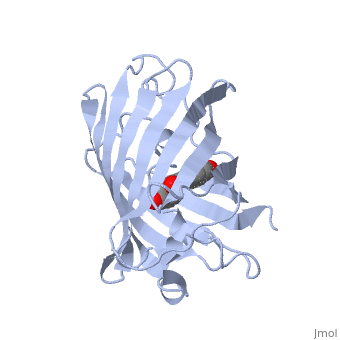Sandbox 8: Difference between revisions
No edit summary |
|||
| Line 1: | Line 1: | ||
<applet load='1ema' size='400' frame='true' align='right' caption='An applet' /> | <applet load='1ema' size='400' frame='true' align='right' caption='An applet' /> | ||
== Uppsala University rules! == | == Uppsala University rules! == | ||
You can take a close look at the chromophore of GFP in the [[1ema|PDB entry]]. The backbone of the entire protein is shown here on the left. The protein chain forms a cylindrical can (shown in blue), with one portion of the strand threading straight through the middle (shown in green). The chromophore is found right in the middle of the can, totally shielded from the surrounding environment. This shielding is essential for the fluorescence. The jostling water molecules would normally rob the chromophore of its energy once it absorbs a photon. But inside the protein, it is protected, releasing the energy instead as a slightly less energetic photon of light. The chromophore (shown in the close-up on the right) forms spontaneously from three amino acids in the protein chain: a glycine, a tyrosine and a threonine (or serine). Notice how the glycine and the threonine have formed a new bond, creating an unusual five-membered ring. | You can take a close look at the chromophore of GFP in the [[1ema|PDB entry]]. <scene name='Sandbox_8/Sandbox_8_pic01/1'>The backbone of the entire protein is shown here on the left.</scene> The protein chain forms a cylindrical can (shown in blue), with one portion of the strand threading straight through the middle (shown in green). The chromophore is found right in the middle of the can, totally shielded from the surrounding environment. This shielding is essential for the fluorescence. The jostling water molecules would normally rob the chromophore of its energy once it absorbs a photon. But inside the protein, it is protected, releasing the energy instead as a slightly less energetic photon of light. The chromophore (shown in the close-up on the right) forms spontaneously from three amino acids in the protein chain: a glycine, a tyrosine and a threonine (or serine). Notice how the glycine and the threonine have formed a new bond, creating an unusual five-membered ring. | ||
http://xray.bmc.uu.se/daniel | http://xray.bmc.uu.se/daniel | ||
Revision as of 17:07, 31 May 2008
|
Uppsala University rules!Uppsala University rules!
You can take a close look at the chromophore of GFP in the PDB entry. The protein chain forms a cylindrical can (shown in blue), with one portion of the strand threading straight through the middle (shown in green). The chromophore is found right in the middle of the can, totally shielded from the surrounding environment. This shielding is essential for the fluorescence. The jostling water molecules would normally rob the chromophore of its energy once it absorbs a photon. But inside the protein, it is protected, releasing the energy instead as a slightly less energetic photon of light. The chromophore (shown in the close-up on the right) forms spontaneously from three amino acids in the protein chain: a glycine, a tyrosine and a threonine (or serine). Notice how the glycine and the threonine have formed a new bond, creating an unusual five-membered ring.
